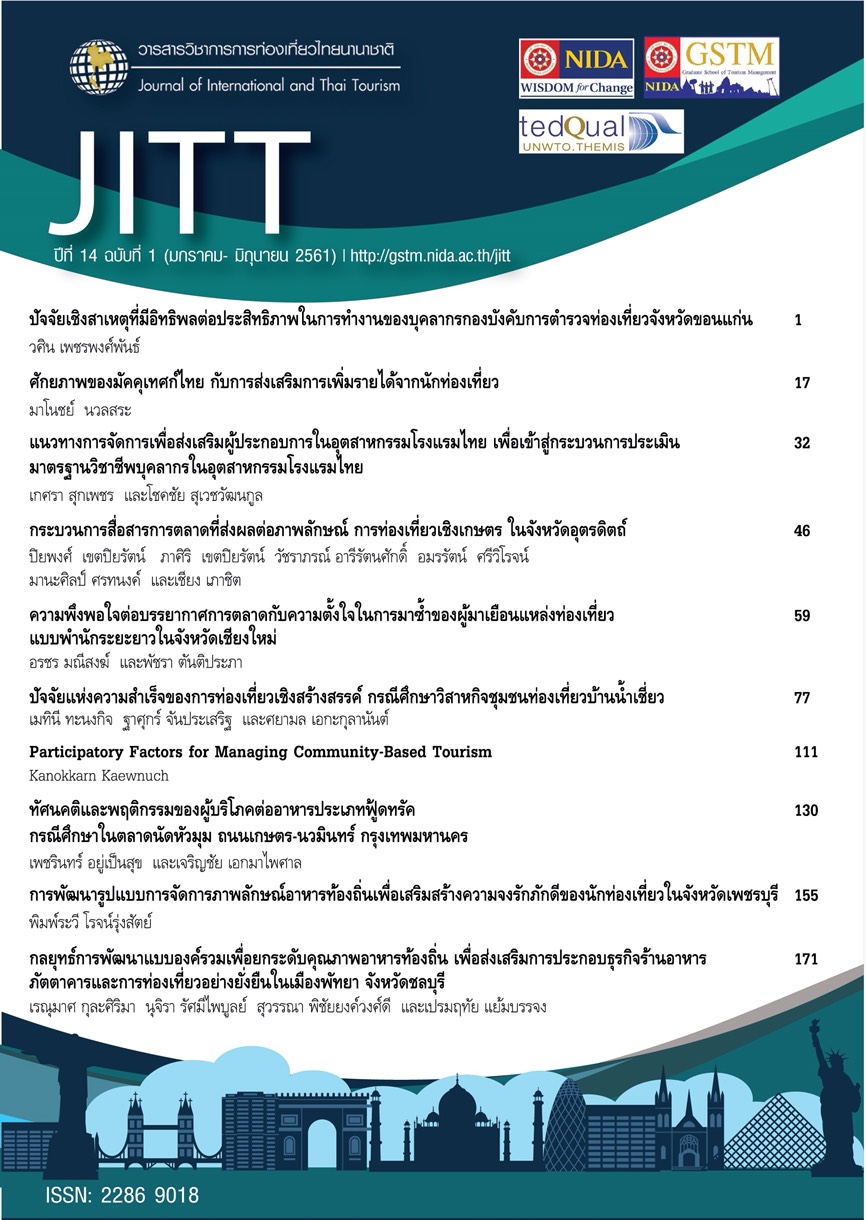การพัฒนารูปแบบการจัดการภาพลักษณ์อาหารท้องถิ่นเพื่อเสริมสร้าง ความจงรักภักดีของนักท่องเที่ยวในจังหวัดเพชรบุรี
Main Article Content
บทคัดย่อ
การวิจัยในครั้งนี้มีวัตถุประสงค์เพื่อพัฒนารูปแบบการจัดการภาพลักษณ์อาหารท้องถิ่นเพื่อเสริมสร้างความจงรักภักดีของนักท่องเที่ยว กรณีศึกษา จังหวัดเพชรบุรี ใช้ระเบียบวิธีวิจัยเชิงปริมาณ ผลการศึกษาพบว่า องค์ประกอบที่มีอิทธิพลต่อความจงรักภักดีของนักท่องเที่ยวได้แก่ ความเป็นเอกลักษณ์ (β=.262) ความคิดสร้างสรรค์ (β =.134) และคุณค่าทางโภชนาการ (β =.117) ผลการวิเคราะห์ปัจจัยที่มีอิทธิพลต่อการเสริมสร้างความจงรักภักดีของนักท่องเที่ยว ด้านการกลับมาซื้อซ้ำได้แก่ ความเป็นเอกลักษณ์ (β =.251) และ ความคิดสร้างสรรค์ (β =.119) ผลการวิเคราะห์อิทธิพลที่มีต่อการมีส่วนร่วมในการปกป้องภาพลักษณ์อาหารท้องถิ่น ได้แก่ ความเป็นเอกลักษณ์ (β =.177) และผลการวิเคราะห์ปัจจัยที่มีอิทธิพลต่อการเสริมสร้างความจงรักภักดีของนักท่องเที่ยวด้านความเชื่อมั่นได้แก่ ความเหมาะสมของราคา (β =.225) และความเป็นเอกลักษณ์ (β =.199) โดยรวมแล้วแนวทางในการพัฒนารูปแบบการจัดการภาพลักษณ์อาหารท้องถิ่นของจังหวัดเพชรบุรีควรมุ่งเน้นด้านความเป็นเอกลักษณ์ ความคิดสร้างสรรค์ คุณค่าด้านโภชนาการและความเหมาะสมของราคา ตามลำดับ
Article Details
References
ธนิต วิจิตรพันธุ์. (2555). เพชรบุรี เมืองหลากมิติ. นิตยสารผู้จัดการ 360 องศา. ค้นหาเมื่อ 25 สิงหาคม
2560, จาก http://info.gotomanager.com/news/printnews.aspx?id=94631.
ปิรันธ์ ชิณโชติ และ ธีระวัฒน์ จันทึก. (2559). รูปแบบการจัดการการท่องเที่ยวเชิงสร้างสรรค์ของสวนผึ้ง.
Veridian E-Journal, ฉบับที่ 1 (มกราคม-เมษายน), หน้า 250-268.
สรายุทธ กันหลง. (2555). การทดสอบความเชื่อมั่นของแบบสอบถาม Cronbach's alpha. Ipernity.
ค้นหาเมื่อ 25 มกราคม 2561, จาก http://www.ipernity.com/blog/248956/424773.
Baloglu, S., & McCleary, K. W. (1999). A model of destination image formation. Annals of
Tourism Research, 26(4), 868-897. Retrieved from
http://isiarticles.com/bundles/Article/pre/pdf/119.pdf.
Boniface, P. (2003). Tasting Tourism: Travelling for Food and Drink. Hampshire: Ashgate.
Boyne, S., Hall, D. & Williams, F. (2003). Policy, support and promotion for food-related
Tourism initiatives: A marketing approach to regional development. Journal of Travel
and Tourism Marketing 14, 131-54.
Cohen, E and Avieli, N. (2004). Food in tourism. Attraction and Impediment. Annals of
Tourism Research Vol. 31 (4) Oct 2004. pp 755-778.
Echtner, C. M., & Ritchie, J. R. B. (2003). The meaning and measurement of destination image.
Journal of Tourism Studies, 14(1), 37-48.
Hair, J. F. (2006). Multivariate data analysis (6th ed. ed.). Upper Saddle River, N.J.: Pearson
Prentice Hall.
Hall, C.M. (2003). Wine food and tourism marketing: Preface. Journal of Travel and Tourism
Marketing 14, xxiii.
Haukeland, J.V. & Jacobsen, J. K. S. (2001) Gastronomy in the periphery Food and cuisine as
tourism attractions on the top of Europe. Paper: 10th Nordic Tourism Research Conference, Vasa, Finland 18–20 October 2001 (on-line) Available from:
http://www.wasa.shh.fi/konferens/abstract/a6-haukeland.pdf (Accessed 16 January 2016)
Hijalager, A. & Richards, G. (eds.) (2002). Tourism and Gastronomy. London: Routledge.
Jameson, F. 1991. Postmodernism or, The Cultural Logic of Late Capitalism (on-line)
Available from:
http://www.marxists.org/reference/subject/philosophy/works/us/jameson.htm (Accessed on 7 September 2016)
Kaspar, C. (1986). The impact of catering and cuisine upon tourism. In 36th AIEST Congress:
The Impact of Catering and Cuisine Upon Tourism. Montreux, Switzerland: AIEST.
Kline, R. B. (2005). Principles and practice of structural equation modeling (2nd ed. ed.). New
York: Guilford Press.
Kozak, M. & Decrop, A. (2009). Handbook of tourist behavior, theory and practice. New York:
Routledge.
Leisen, B. (2001). Image segmentation: the case of tourism destination. Journal of Service
Marketing, 5(4), 49-56.
Long, L. (ed.) (2003). Culinary Tourism: Food, Eating and Otherness. Lexington:University of
Kentucky Press.
Quan, S. & Wang, N. (2003). Towards a structural model of the tourist experience: An
illustration from food experiences in tourism. Tourism Management 25, 297-305.
Du Rand, G. E. & Heath, E. (2006). Towards a framework for food tourism as an element of
destination marketing. Current Issues in Tourism.
Ritchie, J.R.B. & Crouch, G.I.(2003). The competitive destination: a sustainable tourism
perspective. Wallingford: CABI.
Selwood, J. (2003). The lure of food: Food as an attraction in destination marketing in
Manitoba, Canada.
In C.M. Hall, L. Sharples, R. Mitchell, N. Macionis and B. Cambourne (eds.) Food Tourism
around the World. Oxford: Butterworth Heinemann.
Stange, J. Brown, D. (2011). Tourism destination management achieving sustainable and
competitive results. Washington D.C.: US Agency for International Development.
Tourism Queensland (2003). Food tourism. (on-line) Available from:
http://www.tq.com.au/fms/tq_corporate/research/fact_sheets/food_tourism.pdf
(Accessed on 9 February 2016)
Tsiotsou, R. H. & Goldsmiths, R.E. (2012). Strategic Marketing in tourism service. Bingley, UK:
Emerald Group.
Urry, J. (2002) 2nd ed. The Tourist Gaze. London: Sage.

